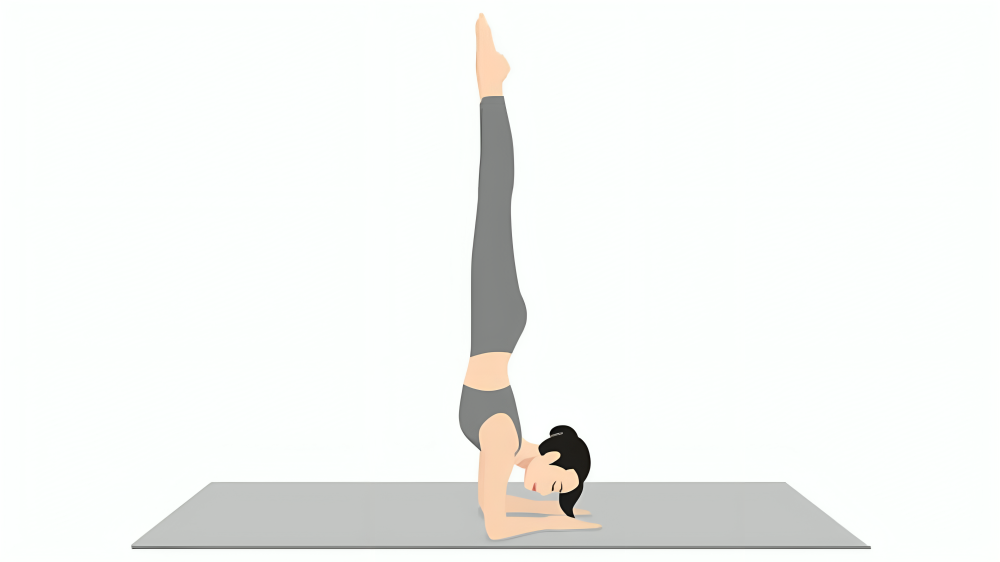
What is Pincha Mayurasana?
Pincha Mayurasana, also called the Feathered Peacock Pose, is a challenging arm balance that really brings into play one’s upper body strength and the stability of one’s core. You are on your forearms in this pose, with your legs up in the air; hence, it is an asana for those at an intermediate to advanced levels. It’s kind of a handstand but done on your forearms, making it a bit easier on your wrists but very demanding when it comes to needing strong shoulders and a great feeling of balance.
How to Do Pincha Mayurasana
Warm Up
Before jumping right into Pincha Mayurasana, make sure to prepare your body with some warm-up poses. Try a few rounds of Sun Salutations and add in some shoulder and core stretches like:
Dolphin Pose (Makarasana)
Downward-Facing Dog (Adho Mukha Svanasana)
Plank Pose
Forearm Plank Pose
These will open your shoulders and set your core, key for this inversion.
Start in Dolphin Pose
Dolphin Pose is your foundation for Pincha Mayurasana.
Come onto your hands and knees, then place your forearms on the floor, shoulder-width apart.
Keep your elbows directly under your shoulders and your forearms parallel.
Tuck your toes under and lift your hips up toward the ceiling, coming into an upside-down V shape, with your body in a line from head to heels, similar to Downward-Facing Dog, only on your forearms. Gaze forward between your hands and initiate the engagement of your core.
Walk Your Feet In
Coming into Dolphin Pose, start to tiptoe your feet forward toward your elbows. The closer you bring the feet forward, the higher the hips lift, and the easier it is to balance.
Practice Lifting One Leg
If you feel stable, try lifting one leg toward the ceiling. It does not have to go straight up just yet-just get used to shifting more weight onto your forearms.
Keep the lifted leg straight and strong while the other leg stays grounded.
Engage your core and press firmly into your forearms.
Kick Up
Take a deep breath, and as you exhale, kick your grounded foot off the floor, trying to bring both legs together in the air.
If you’re near a wall, kick up into this pose with the wall behind you for added support.
If you cannot get both legs up at first, do not worry. This takes time!
Hold the Pose
Once you’ve made it up into the forearm stand:
Engage your legs, squeezing them together, and point your toes towards the ceiling.
Keep core engaged and length in the neck. Do not collapse onto your shoulders, but rather engage them and support yourself.
After a few breaths-or many more if you can-when you’re ready to head back down, slowly lower one leg at a time back down to dolphin.
Benefits of Pincha Mayurasana
Strengthens Upper Body and Core:
This pose is great for strengthening your shoulders, arms, and core. You use your body weight to stay up, working out muscles you don’t usually work.
Enhances Balance and Stability:
The balance of your forearms requires concentration and awareness of your body. Gradually, this asana can help in improving the overall balance and coordination of your body.
Improves Confidence and Focus:
Confidence to nail such an inversion like Pincha Mayurasana does help! Then again, you have to focus in the pose to maintain a balance, which helps to keep your mind quiet and enhance its concentration.
Improves flexibility:
It is a strength-based asana; it also requires opening of your shoulder, chest, and hip. These can give great overall flexibility with time and practice.
Releases stress and anxiety:
Generally, inversions cool the mind. The flip over sends fresh blood to the upper part of the brain, relieving stress and anxiety.
It’s here Kakasana how to do it and what are the benefits
FAQs
1. What is Pincha Mayurasana?
Pincha Mayurasana, also known as the Feathered Peacock Pose or Forearm Stand, is an advanced yogic inversion that balances the body on the forearms with the legs lifted upward toward the air. It involves a series of strengths, flexibilities, and balancing postures.
2. Should I necessarily be an advanced yogi to give a shot at this Pincha Mayurasana?
Not necessarily! Even though it’s an advanced pose, it could easily be worked up to by a beginner through building strength and practice of modifications-such as using a wall for support. Patience and consistency are important.
3. What are the main benefits of Pincha Mayurasana?
This posture helps in strengthening the upper body and enhances core stability. Also, it regulates balance and confidence and opens up your shoulders and spine while reducing stress by improving the concentration of your focus.
4. Can I do Pincha Mayurasana if I have any wrist pain?
Yes! One of the greatnesses of the pose is that, being on your forearms, you take pressure off of your wrists. However, be careful in this pose if you have an injury to the shoulders or elbows, and always consult a yoga teacher or doctor.
5. How do I begin to work my body up to Pincha Mayurasana?
The preparatory postures for warming up can include Dolphin Pose, Forearm Plank, and Downward-Facing Dog; these asanas will prepare your shoulders and core. Strength in your shoulders and core is a necessary pre-requisite to avoid injury while doing Pincha Mayurasana.

